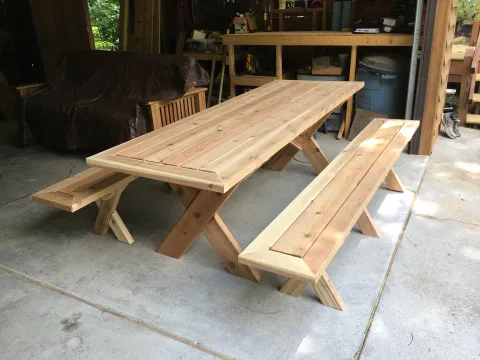Do the Math

After finishing the patio area in our backyard there was an open area inside the arc of crepe myrtles that my wife said would be the perfect place for a picnic table. After much discussion we decided on a modification of a design we found on the net, shortening the length from eight feet to seven and making it eight 2x4’s wide instead of seven. The only place I could buy cedar lumber was at the other end of Knox County, a mildly inconvenient trip made more so by the pandemic. I bought two extra of both 2x4’s and 2x6’s, which turned out to be a good thing.
The site where we found the “plans” for the table and benches was long on narrative and short on specifics, like how long to cut the boards and what angle to cut the legs to let them rest firmly on the ground. I assume the plans were intended to be a starting point for the builder to use, allowing the creativity to flow.
At one time I was pretty good at math (although high school graduation was half a century ago), so when the directions said to decide how tall we wanted the table to be and then just use the Pythagorean theorem to calculate the length of each leg board, I was not intimidated. As it turned out, I should have been.
Calculating the length of the diagonal boards that make the legs of the table (and benches) involved allowing for the thickness of the table, factoring in the width of the boards, deciding if the leg should extend past the edge of the table, and determining the angle needed for each cut. At one time or another I made each of these calculations incorrectly, which is one reason buying a couple of extra boards was a good idea.
At least once (okay, twice) I was thinking about what great fuel all these cedar boards would make for our fire pit, but I managed to work through most of the issues and complete the project. If viewed from a distance, it looks pretty good, but a close inspection would leave any decent woodworkers either shaking their head or trying not to laugh out loud.
The fact that I had algebra and trigonometry a long time ago helped, but not a lot. Even though I could find formulas and calculators on the internet, I still had to apply them correctly. There is a way to think about math; it’s pure logic and very unforgiving. One incorrect number results in a mistake that can snowball through the entire project. I should have remembered what I told my students on numerous occasions, that whatever you’re working on, you can save time, materials, and frustration if you just learn how to do the math.
- Log in to post comments
math
At least you understood it at one time!! I always struggled with math. I love your picnic table, though. It's beautiful, Jim.